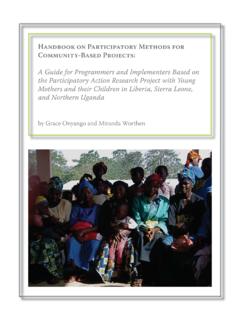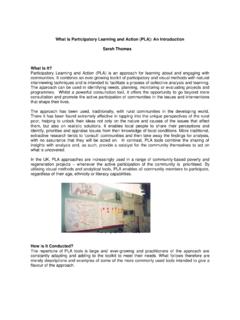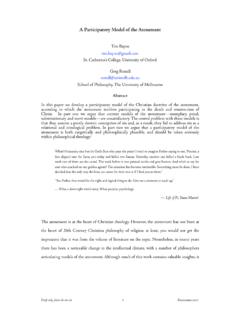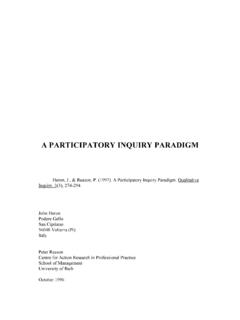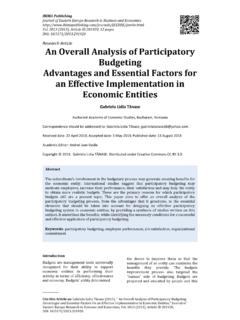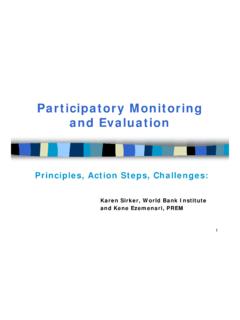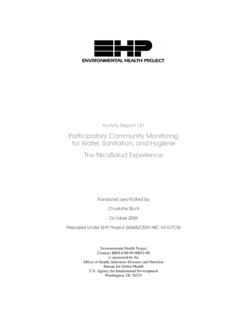Transcription of Participatory Action Research - VISION Management
1 Participatory Action Research - A guide for community-based organizations - January 2003 Ruth Armstrong, MBA BASED ON THE Action Research CARRIED OUT AT PARTICIPATION HOUSE SUPPORT SERVICES LONDON AND AREA Table of Contents page Introduction 1 Participatory Action Research 3 Deciding to do PAR 4 Designing a PAR Project 6 Carrying out a PAR Project 9 Communicating the Results of a PAR Project 13 Evaluation 14 Summary 15 References 16 Implementation Tools: Appendix A PAR Steering Committee: Terms of Reference Appendix B Confidentiality Appendix C Sample of Sources of Evidence from PH Process Appendix D Face Sheet Appendix E Guidelines for Open-Ended Interviews Appendix F Themes Focus of Interviews Appendix G Questionnaire to Guide Stories Appendix H Focus Groups Appendix I Evaluation of PAR s Impact Participatory Action Research A guide for community-based organizations Participation House Support Services London and Area Page 1 INTRODUCTION Why was this guide written?
2 Participation House Support Services London and Area (PH) embarked on a voluntary self-initiated project to evaluate the impact of their mission and principles of service on the individuals they support. The Quality Outcomes for People Committee, a committee established by the Board of Directors, considered a number of approaches before deciding on a Participatory Action Research (PAR) approach to evaluation. PAR has since been embedded into PH s organizational processes for purposes of evaluation, accountability and internal benchmarking of service excellence. This guide was originally conceived: to provide Participation House (PH) with a tool to continue to evaluate their programs in a practical, credible way. The Quality Outcomes for People Committee then decided to share their experiences and PAR methodology with other community-based organizations in the hopes of contributing knowledge to the larger field.
3 This guide is the resulting product that offers: to share the lessons learned at Participation House with other nonprofit service agencies; to provide a practical guide for agencies who wish to use this evaluation approach; to describe an evaluation approach that is particularly relevant to, and focused on, the nonprofit community-based sector; to document an evaluation approach that responds to pressures of accountability, simplicity and responsiveness. The effectiveness and sustainability of organizations is directly related to their ability to learn from their own experience. Community Development Resource Association Participatory Action Research A guide for community-based organizations Participation House Support Services London and Area Page 2 Who is this guide for? This guide was primarily written for PH s Board and Staff so they can continue to evaluate their programs.
4 This guide can be useful to nonprofit community-based service organizations with limited funds to design and implement meaningful evaluations. The PAR method of evaluation has been adapted to the needs of these organizations so that accountability and continuous improvement can take place. This method is particularly suited to evaluations that benefit from being qualitative, responsive and participative. This method combines quantitative and qualitative methods to achieve both Action and Research results. This guide can be useful to sister organizations and funders in suggesting an evaluation method that is both practical and effective. Participatory Action Research A guide for community-based organizations Participation House Support Services London and Area Page 3 Participatory Action Research What is it? Participatory Action Research (PAR) is a Research method that is qualitative, quantitative and participative.
5 It has as its twin goals the achievement of both Action and Research in the same evaluation method. Participants (eg. individuals receiving service and family members) are involved in collecting and interpreting data. The data can be a combination of quantitative and qualitative indicators. This combination strengthens the qualitative data, provides a deeper understanding of the quantitative data and leads to Action more directly. Participatory Action Research has a number of characteristics: Participative clients, staff, board and other stakeholders are involved as partners in the Research process; Qualitative it focuses more on descriptions than numbers; Reflective critical reflection on the process and outcomes are important features of the process; Responsive it is able to respond to the emerging issues of a situation which can lead to Action ; Emergent and cyclical the process takes places gradually over a number of cycles so that interpretations of data can be tested, challenged and refined.
6 Why is it useful? In some community or agency settings it may be difficult to use traditional evaluation-experimental- Research methods. To achieve both understanding ( Research ) and Action requires responsiveness to the situation and the people involved. Some questions and methods to answer these questions are imprecise in the social/human service sectors. PAR enables participants and researchers to learn from experiences and move towards a better understanding of elusive matters. The cyclic process of including planning, review and learning allows the collected data to be used critically for understanding and Action . The quality of the evidence can be continually improved by using many sources of data collection. Participatory Action Research A guide for community-based organizations Participation House Support Services London and Area Page 4 DECIDING TO DO PAR How to prepare To Begin Research is the systematic collection and analysis of information.
7 Research begins with a question: What is it that we want to know? How can we tell that what we are doing is having an impact? Do we have the information we need to make decisions and take Action ? We need to clarify the question we want to ask. Participation House asked the question: Are we fulfilling our promise (mission, quality outcomes) and obligations (principles of service) to the people we support? The decision to launch an evaluation process follows. This decision is usually made at the board and/or at senior Management levels. Once the decision is made, put a structure in place to oversee the process and report to the Board. Whom to involve A Steering Committee Organize a committee, reporting to the Board of Directors, who will participate in and oversee the design, implementation, analysis and results of the PAR project (see Appendix A for sample terms of reference).
8 PH named their committee Quality Outcomes for People Committee to reinforce the focus of their evaluation and accountability. Bring together a variety of people with different skills and interests as well as a commitment to the organization. Committee members should include board, community and senior staff. Engage an external consultant to lend expertise, credibility and neutrality to the process. The consultant will guide the project and produce the resulting report. Participatory Action Research A guide for community-based organizations Participation House Support Services London and Area Page 5 Participants in the Research Partnership Identify who will be participating in the Research . At PH the Committee identified the people they support as the focus of the evaluation. Family and staff assisted1 as required.
9 All became partners in the Research . Consider involving neighbours, community members (stores, banks, community centres) and agencies as part of your Research . Ensure that the selection of participants is random (especially in large organizations) and/or unbiased to avoid skewing the results. PH used a combination of: inviting people to volunteer to participate in the project; ensuring participants came from different homes and family situations; and including individuals with various capacities to communicate verbally. The selection process was reviewed by the external consultant and approved by the Board. PH hopes to engage most, if not all, individuals and families in this process over the next few years. Steps in Preparing for PAR 1. Think about what you want to learn. 2. Decide how you can answer your questions. 3. Decide what you need to proceed.
10 4. Decide who should be involved in the evaluation. 5. Estimate the cost of doing the evaluation. 6. Develop a time frame and critical path. 7. Decide what to do with the findings. 1 Some staff and family members helped by facilitating the communication between the individual (particularly those who were nonverbal) and consultant. Participatory Action Research A guide for community-based organizations Participation House Support Services London and Area Page 6 DESIGNING A PAR PROJECT How to develop a design The design outlines: the kind of information to collect and why; how to collect the information; and from whom (consider random selection) to collect the information. The design sets the framework for defining what the process is, how individuals participate in it and how the pieces fit together.
